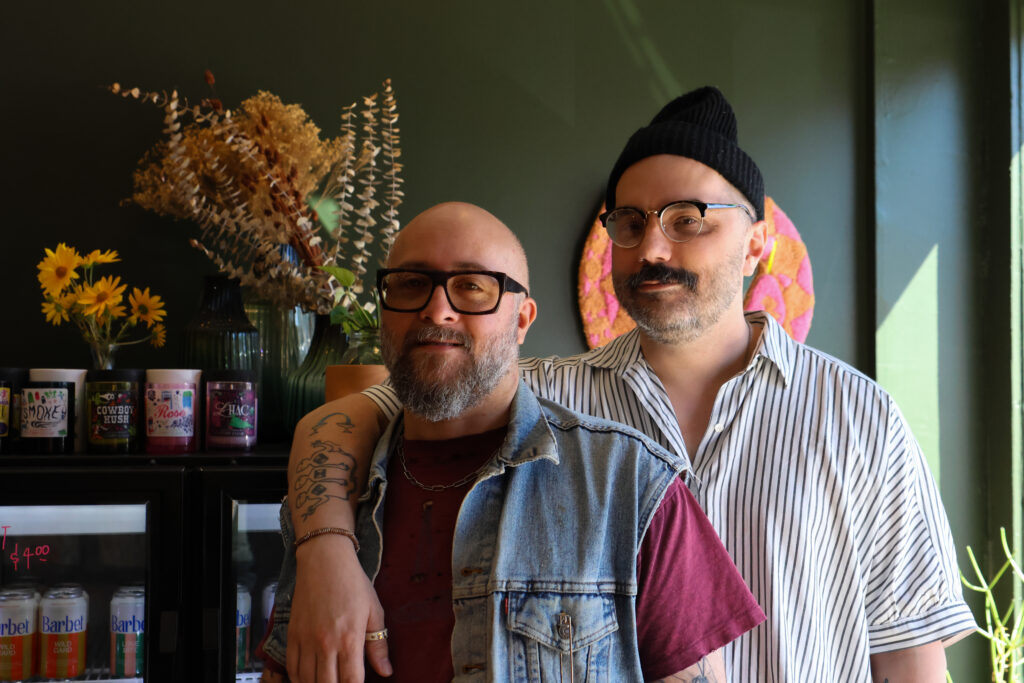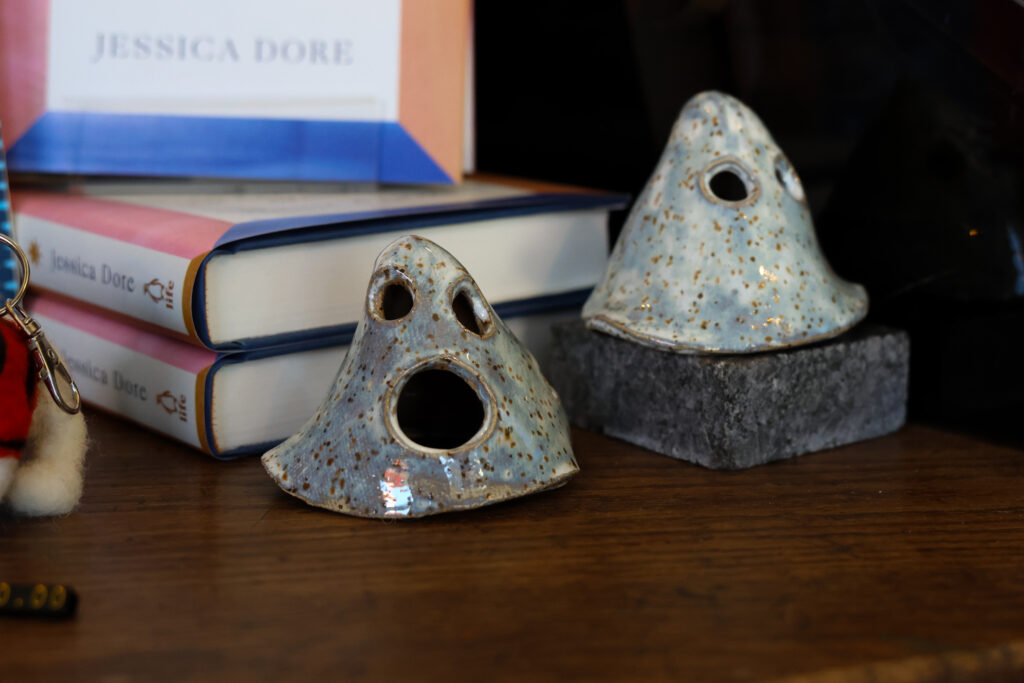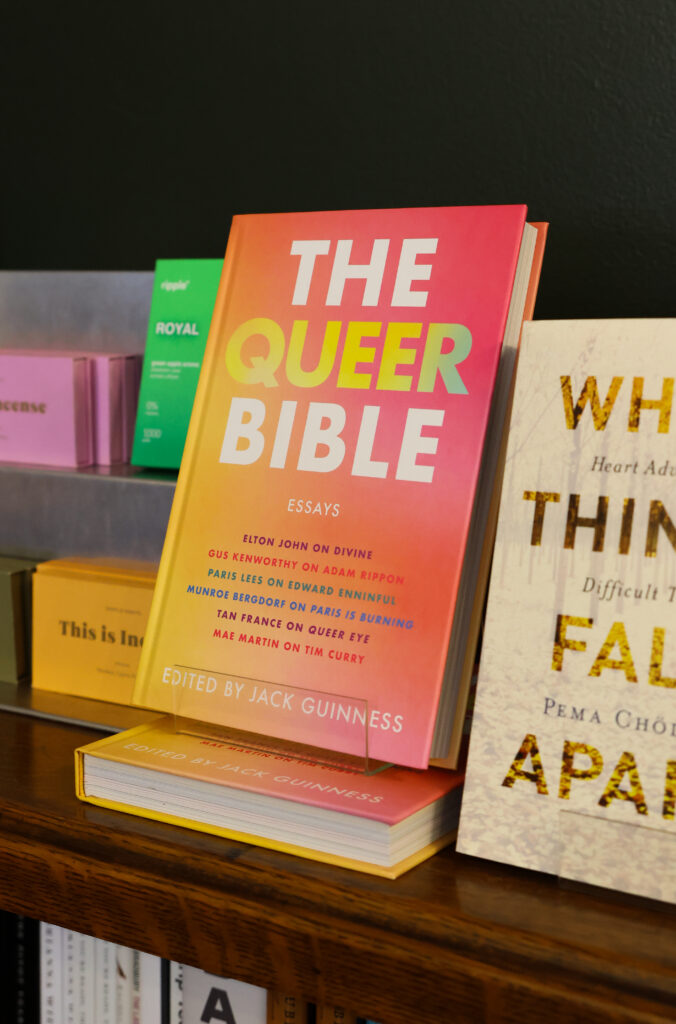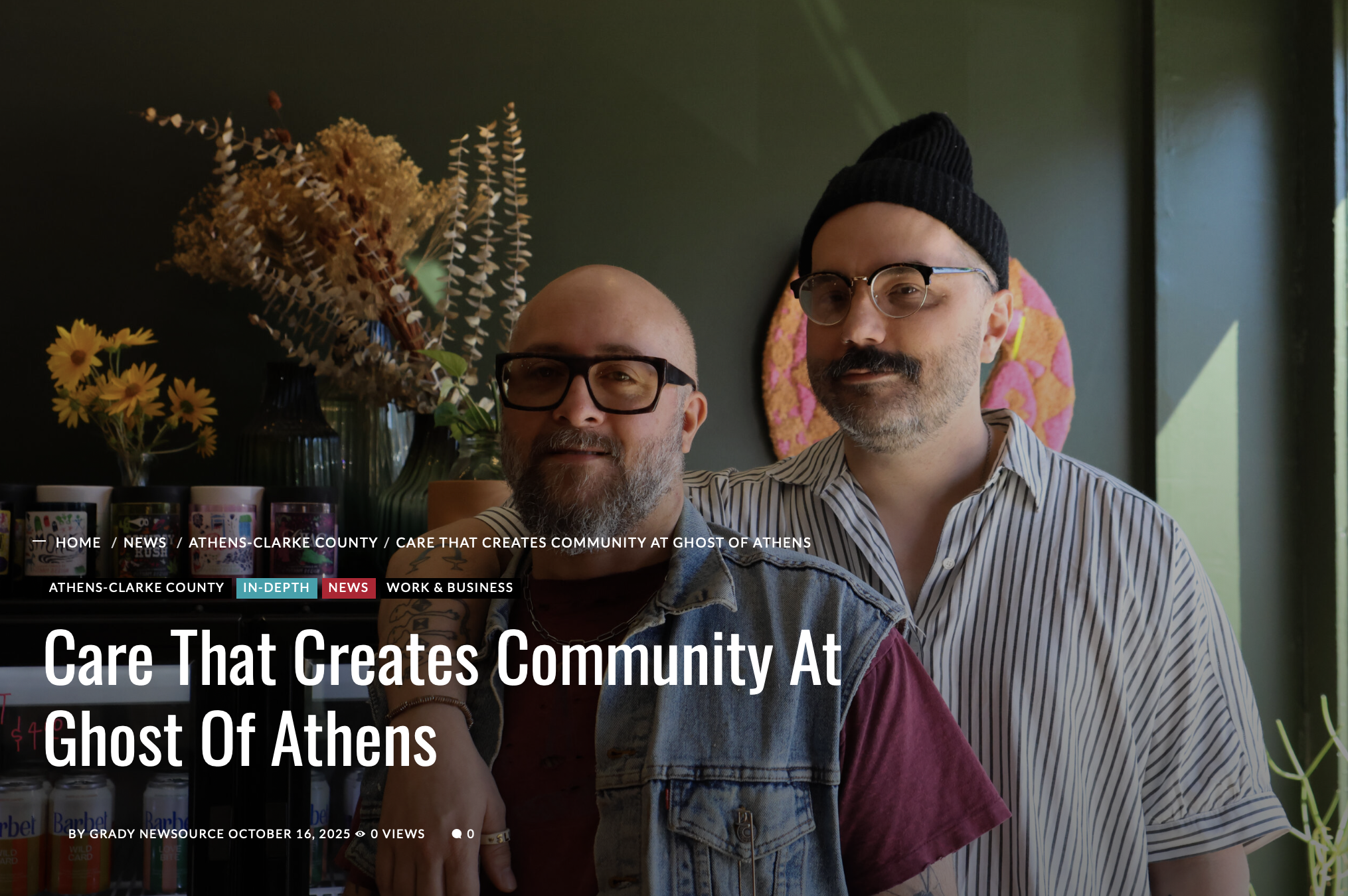Reporter Annotations are meant to get to the how and why behind Newsource’s reporting through in-depth conversations with the reporters themselves. Have a listen or read the conversation below for how fourth-year journalism major Addison Simmons covered her first photo essay along with a business story for her Reporting III course: “Care That Creates Community at Ghost of Athens.”
Hello and welcome to Grady Newsource’s Reporter Annotations. I’m Alex Perri, a graduate student at the University of Georgia studying journalism at the Grady College of Journalism and Mass Communication, and I’ll go ahead and let Addison introduce herself.
Addison Simmons: Hi. I’m Addison Simmons. I am a fourth-year journalism student at the University of Georgia.
Perri: Thanks. Addison, awesome. Why don’t we start by you telling me a little bit about yourself, what you like to do in your free time, and then we’ll kind of go from there.
Simmons: I have always loved writing. I grew up always wanting to be a writer, whether that was books or journalism. Kind of a big goal from a young age of mine was to write for a living, and that translated a bit into reading as well.
As I’ve grown older, a big passion of mine has also been reading. I’m actually an English minor here, so I do journalism; it’s like my main priority, but I also love to do the English classes and reading in my free time. That’s kind of how I got introduced to Ghost, what I wrote my story about. I noticed that they had a bunch of books, and they were a new spot in Five Points in Athens this summer, so I started going pretty frequently.
Perri: Where are you from originally, Addison?
Simmons: I’m originally from Dalton, Georgia, which is very northwest Georgia. It’s like 40 minutes from Chattanooga, Tennessee, so pretty much up there on the border.
Perri: And how did you end up choosing the University of Georgia and Grady (College) as the track you wanted to go down?
Simmons: It kind of goes back to me always wanting to do writing. Growing up, I remember being in second grade looking up schools that I can go to and write at, and Grady was one of the first things that popped up because UGA has such a good journalism program. It’s been a goal of mine since second grade, and my dad went to UGA, so I have an alum in the family.
He was always encouraging us to be Georgia fans. So it kind of seemed like the only path for me. I wanted to go out of state for a while, but I kind of came back to Georgia and have loved it here.
Perri: That’s good to hear. It sounds like it’s in your blood a little bit. Today, we are going to be talking about your story that was published on Grady Newsource titled “Care That Creates Community at Ghost of Athens.” Can you start off by telling me what your experience has been in journalism and reporting up to the writing this story?
Simmons: The first class everybody takes is Reporting I at Grady. So I started off in Reporting I, and did the sustainability beat about a year ago, and that was kind of just dipping my toes in the water of journalism.
I remember getting into Grady and being very excited, but also very nervous that I was going to start taking classes like journalism classes, and doing the things that I will hopefully do as a career one day, and discover that I wasn’t good at it or didn’t like it. So that was kind of just a lot of me experimenting and trying to figure out if this is even what I’m supposed to be doing.
And I was very lucky. I discovered that I really do like journalism. So Reporting I was a lot of me trying to learn AP style rules and a lot of just dipping my toes in the water, but I feel like I really kind of found my passion in photojournalism.
This past year, my second semester in Grady, I took Intro to Photo(graphy) with Dr. (Kyser) Lough, and it was a lot more challenging than I thought it would be. But I kind of got into the flow of it and found that I really love telling stories through photos, which was a curveball for me because, as I’ve said, I’ve always been so into writing. I always just assumed it would just be like writing classic in print journalism for me. But I really love photo, and I’ve taken Advanced Photo with Prof. (Mark) Johnson this semester, and I’ve really been trying to create a path for myself going forward where I can pursue a career in photojournalism. I’ve really been trying to push myself recently with that, and in Reporting III, we’ve done multimedia journalism. It’s a lot of audio, video, broadcast stuff, but the unit that I enjoyed the most was the photojournalism unit, and that was what I wrote this story for.

Perri: Very cool! That was really the thing that drew me most to this story. I love the cover shot, which is an image of the owners, Dave Ranney and Robbie Bailey. And they’re standing, kind of one in front of the other, with one of their arms kind of draped over each other, and the lighting is really beautiful. I also think it is a great intro to this profile of this business, that is a little bit different from other businesses in Athens. It’s a little off-kilter. And I think that strong photography is really important in a piece like this, when what they’re selling is physical merchandise. So, tell me a little bit about how you blended your writing storytelling with your visual storytelling here.
Simmons: Our task for this assignment was to do a photo essay. So it’s very heavy on photos because I went in trying to get, like, 10 photos, I think, was the requirement. And I left with about 30 photos that I liked. So I had to narrow them all down. I went in first, and I asked if I could take a couple of portraits of them to start out. I wasn’t sure what kind of photos I was going to get of the merchandise and stuff like that yet, so I wanted to take some portraits, interview them, hopefully get them a little more comfortable with me, and then spend a little more time in their shop.
That cover photo of them by the window was, I think, one of the first photos I took, and they naturally posed like that. That was something I loved about this story in general is they were very welcoming and receptive to me. So it was really a wonderful interview, and I had a great time taking portraits and stuff of them. But after the interview, I got some photos of merchandise, of things that they talked about in the interview, so hopefully I could incorporate some quotes with things that they talked about. These little clay pottery pieces are little ghosts that they talked about in the interview, that they sell from a program called the Little White House, which is an after-school program in South Carolina, and it’s made by people with autism. So I was sure to get a photo of those, so I could put a quote in the caption. And then I was sure to get a photo, lots of photos, of the books, because Robbie Bailey talked about how much books mean to him, and I was sure to get a photo of Dave Ranney’s photo of his great, great grandparents. He talks about how they inspired him to open up a store, so I wanted a photo of him holding that photo.
I think it really came down to, as I was interviewing them, working to stay present and engaged in the conversation, but also trying to think what I would want photos of after the interview, and kind of not being afraid to linger afterward and just take photos of things around their store.


Perri: I can tell that you put a lot of thought into the moments that you chose to capture, and I appreciate that this was your first time writing a piece and doing this in-depth photo essay at the same time.
Simmons: Yes, this was my first time. I’ve written some articles for the The Red & Black, stuff like that, and I had gotten photos for them. But this is the first time I really was kind of putting my all into both sides of it. Usually, I’m just kind of looking for, like, a cover photo for a story or something. But this one, I really wanted many photos to incorporate. And like I said, it really took me being engaged in the interview and really thinking through what I would want photos of.
So, I would say it was definitely more intentional with this one, thinking of ways to tie together the written and the visual part, which was very fun because I feel like I could kind of see the story forming in my head and see what I wanted to visualize and where I wanted it to go.
Perri: Very cool. Did you have any challenges balancing the demands of both of those jobs? Historically, there’s been photographers and then there’s been reporters, but increasingly those jobs are melding into one. Was that something you experienced?
Simmons: Yeah, I feel like I have a lot of internal conflict with multimedia journalism in general, as I’m kind of getting ready to go into the career field. It’s something that I argue with myself a lot, that I’m like, I have to be good at everything. But it’s hard sometimes because, as humans, I don’t know that we are supposed to be perfect at everything and be able to juggle everything. So it’s definitely something that I personally am constantly debating if I want to commit myself to something like that or not, or if I would like to kind of just go into a more niche category of journalism. But luckily for this one, it wasn’t too demanding. I feel like photo and writing are kind of both my passions, so it’s something that the more I do it, the more I see them go hand in hand. And I really feel like this one kind of fell into place perfectly.
Perri: Had you written these kinds of stories before? Were you familiar with this kind of business profile, and were you familiar with writing stories with queer protagonists?
Simmons: I don’t think I’ve ever written a business profile before, but I think with this one, it was pretty easy, because I typically like to write people-based stories, and Dave and Robbie, they’re both such prevalent owners of the store. I personally shop at Ghost a lot. So every time I go, they’re both working there, like they have no other workers. They’re very much present in their community, which is why I kind of wanted to focus on the community side of their store more because they do prioritize that so much more. And I really just thought it was a beautiful mission that they have. They’re very welcoming. I went in hoping to get a 20-minute interview, and ended up getting a 40-minute recorded interview. And I ended up sticking around and talking to them off the record for like 30 more minutes.
They really were just wonderful people, and I feel like I could have taken this story in 20 different directions because they have so many amazing missions out of their store. It was my first business profile, but it definitely made me want to do more because they showed me how I can incorporate more of a people perspective into those stories.

many sold at Ghost. “We have a true self-care section, all kinds of workbooks and notebooks
and tools to help you work through those difficult things in life,” Ranney said. (Photo/Addison Simmons)
Perri: What are some of the stories that you had been working on leading up to this? I know that a lot of times in undergrad, you’re kind of building your skills one by one. You start off with like a news brief or something, and then you step up into bigger and bigger stories. What were some of the steps that you took leading up to this?
Simmons: I would say definitely, it’s been more cut-and-dry stories in the past. In Reporting I, we went to a county commissioner’s meeting, and that was very much just what they talked about in the meeting, who was present. Sometimes, I feel like journalism can be a lot of just like this is exactly what happened, and this is who it’s impacting, which has its importance, but it can get kind of boring sometimes. So, I do enjoy having more creative freedom with stories like this. And I feel like it’s always good to have a good foundation in general because I do need to know the AP rules and how to write articles in general. But I think this is my favorite one that I’ve written this semester, at least.
Perri: I want to ask, what are some specific things that you’re proud of with the finished product?
Simmons: I really think I got some good quotes. I feel like it was beneficial for me to have a more conversational interview. Sometimes I can get a little nervous and just stick to the script that I have written before, but I really allowed myself to follow the conversation wherever it was going, which also allowed me to get a longer interview out of them, because I could always circle back to questions that I skipped over and things like that. But it, really, it just allowed me to have more of a personal conversation with them and let the story tell itself.
Perri: And then looking back on the finished product, are there any lessons you learned where you’re like, “Moving forward, I really want to make sure I do this,” or “I wish I had done this in the moment, but now that it’s finished, I know that I’m gonna maybe change that going forward?”
Simmons: I think I wish I had gone back for more photos because I do like the photos I got, but looking back, technical things that I’m like, oh, I should have done that differently, and I had a couple more days before turning this in, so I could have gone back and taken more photos. But I think I was nervous that they would be sick of me if I was like, “I’m back.” I kind of stopped myself, but sometimes I feel like you have to push yourself out of your comfort zone, and it pays off more. So I do like the photos I got that. I think I could have gotten better ones if I went back.
Perri: I find that a lot when I’m maybe past the point of no return in a story where I’ve done all the reporting and now I’m sitting down to write, I think, God, I wish I would have done this, or I wish I would have focused more on that, but it’s hard as a student, because you’re still learning, and you know, you got to give yourself grace where you can, but also push yourself to grow. And so that’s a tough balance, but I think it turned out well. I want to ask you now, after you’ve gotten this under your belt and it’s one of the bigger projects you’ve accomplished, where are you hoping to take your reporting next?
Simmons: We are actually about to go into video for my Reporting III class, which is always something that’s been kind of daunting for me, just because I don’t see myself like as an in-front-of-the-camera person, which is why I think I enjoy photo journalism so much because it allows me to show other people how I process the world through my own lens, without having to stand in front of a camera and tell people how I process the world. But with video, that’s kind of what you have to do sometimes. So I’ve been kind of nervous for video, but I do think having a background in photo will allow me to have a bit more insight into video, into what technically is good or not.
I’m hoping to challenge myself with video and make something I’m proud of.
Perri: I’m excited to see! I hope it turns out great. My final question is, what’s your dream? What do you hope to accomplish once you go into the world as a journalist?
Simmons: I don’t know right now. I’ve always wanted to do travel journalism, or not travel journalism but just go and tell stories of different communities and different places. I did a Maymester a couple of years ago along the Eastern coast, where I was able to tell stories of Gullah Geechee community members and aquaculture specialists, and it was probably the most impactful thing I’ve ever done with journalism, and I really want to do that in the future, just really commit myself to a project where I can go out and kind of amplify those unheard voices. I think it would be really awesome to do that with photojournalism. So hopefully, whatever I do in the future, it involves photojournalism because that’s really what I’ve grown to love recently. But yeah, I kind of just want to get out there and see what stories need to be told.
Perri: Addison, thank you so much. I really loved your story, and I wish you the best of luck.
Alex Perri is a graduate student in the journalism program at the Grady College of Journalism and Mass Communication.









Show Comments (0)